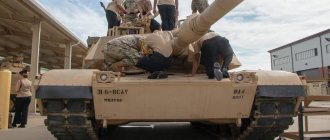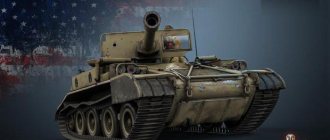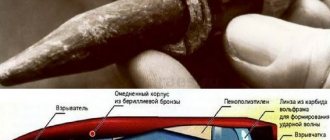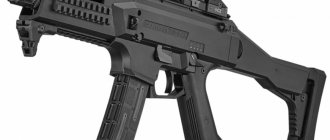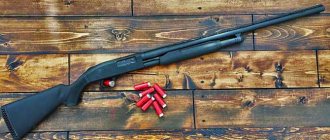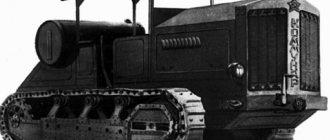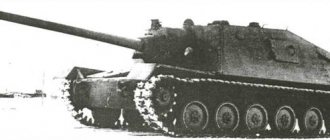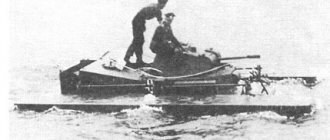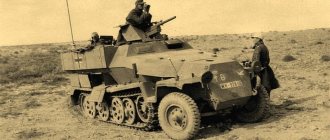Content
- 1. History
- 2 Serial production
- 3 Construction 3.1 Armored hull and turret
- 3.2 Armament
- 3.3 Surveillance and communications equipment
- 3.4 Engine and transmission
- 3.5 Chassis
- 5.1 CVR(T) family
- 6.1 Modern
- 8.1 British Army
UK Armored Scorpions
Over the past few months, the British ISAF military contingent in Afghanistan has gradually been re-equipped with modernized, tracked combat and support vehicles of the CVR(T) Mk 2 series based on the light armored British Scorpion reconnaissance tank.
Military equipment was supplied to units of the Royal Reconnaissance Regiment "9th/12th Royal Lancers", which is located in the Helmand province of Afghanistan. New vehicles were transported to Afghanistan by Russian An-124-100 transport workers. The armored vehicles of the “CVR(T) Mk 2” series, which became operational for the peacekeeping contingent, have already taken part in military conflicts.
In December 2010, BAE Systems entered into a contract with the British Defense Department for the accelerated modernization of 58 light reconnaissance vehicles "CVR(T)" under the "Transformer" project for British peacekeeping forces in Afghanistan, the estimated cost of which is $50 million.
BAE Systems Corporation, even before concluding the contract, successfully tested production prototypes of the CVR(T) - two Spartan Mk 2 armored personnel carriers and one Scimitar Mk 2 armored personnel carrier - in Jordan.
7 combat vehicles are already in Afghanistan on combat duty for the British peacekeeping forces. Delivery of the modernized equipment will last until spring 2012.
The following military equipment will undergo modernization:
— armored personnel carriers of the “FV103 Spartan” series; — military ambulances of the “FV104 Samaritan” series; — control vehicles “FV105 Sultan”; — evacuation and repair vehicles “FV106 Samson”; — combat reconnaissance vehicles of the FV107 Scimitar series.
The history of the creation of combat vehicles of the CVR series
“CVR” is an abbreviation for “Combat Vehicle Reconnaissance,” which literally translates from English as “combat reconnaissance vehicle.” Purpose: reconnaissance and combat use. Created specifically for air transportation to the scene of action. In the 70s of the last century, with the advent of armor manufacturing technology using aluminum and its alloys, the era of armored vehicles on tracked bases, with automotive units and assemblies began. The first company to undertake the creation of a light tank was the English one. The first samples of new equipment successfully completed factory and combat tests at the end of the 70s, and in 1972 the first light tanks were put into service. The tanks are called "Scorpion" series FV-101 according to the English internal designation system; according to the general system, the tank is called "CVR (T)". The letter “T” in the designation means that the vehicle has a tracked base.
The combat vehicle received the name “Scorpion” because of the location of the turret, which makes it look like the tail of a scorpion.
The car has a regular six-cylinder gasoline engine with a power of 195 horsepower, a manual transmission with 7 reverse and forward gears. The track rollers for the caterpillar track are made of aluminum alloys, the track track is made of steel.
Main characteristics:
— length 4.4 meters; — width 2.2 meters; — height 2 meters; — machine weight is about 8 tons; — team of 3 people; — speed up to 90 km/h; — range up to 650 km; — armor protection against ammunition up to 12 mm caliber; Armament: - artillery gun 76.2 mm caliber, ammunition 40 shells; — 7.62 mm machine gun, 3000 rounds of ammunition;
Equipment options based on the “CVR(T)” project:
Stryker FV-102 series self-propelled ATGM with Swingfire ATGM. Purpose - counteraction and destruction of enemy heavy armored vehicles.
center]
[/center]
Armored personnel carrier "Spartan" FV-103 series with a 7.62 mm machine gun. Purpose: transportation of special teams, reconnaissance operations.
Control vehicle "Sultan" FV 105 series with a 7.62 mm machine gun. Purpose - company command control vehicle.
Military ambulance "Samaritan" FV-104 series. Purpose – transportation of up to 5 wounded soldiers.
Reconnaissance and escort vehicle "Simitar" FV107 series with a 76 mm artillery cannon. Purpose - reconnaissance of the area and escort of auxiliary vehicles.
Recovery and repair vehicle "Samson" FV 106 series. Purpose - auxiliary vehicle for units with "CVR(T)" vehicles. Evacuation and movement of both the CVR(T) itself and other armored vehicles.
History[edit]
By the early 1960s, the reconnaissance units of the British Army were armed only with the Ferret and Saladin armored vehicles, adopted in 1952 and 1959, respectively. Although both of these vehicles proved to be very successful, by the 1960s the British Army had a need for a new reconnaissance vehicle due to changes in military doctrine. During the 1950s, the ever-increasing costs of maintaining large military contingents in remote parts of the world gradually made it increasingly problematic for Britain to support them. Therefore, by the 1960s, with the development of transport aviation, a new military doctrine was formulated at the General Staff, according to which permanent garrisons were to be replaced by rapid reaction units stationed in the UK, which could be quickly delivered by air to the emerging “hot spot” " It was planned that reinforcements, heavy weapons and equipment, in particular armored vehicles, would later be delivered by sea, but it was obvious that the units delivered by air also needed armored vehicles capable of both providing fire support and, if necessary, fighting enemy armored vehicles. Thus, the need arose for a new light armored combat vehicle, capable of simultaneously acting effectively in a reconnaissance role, with sufficient firepower to support infantry, but at the same time light enough to be transported by military transport aircraft. The development of such a vehicle, which received the symbol AVR
(Armored Vehicle Reconnaissance - reconnaissance armored vehicle),
was entrusted by the General Staff to the Center for the Study and Development of Combat Vehicles in 1960, initially with the aim of also determining how feasible a combination of such requirements is in practice.
"Simitar" of the British Marine Corps.
Initially, the General Staff did not put forward clear requirements for the vehicle, with the exception of the roles it was supposed to perform. Thus, the designers were not even limited in the choice of the vehicle’s chassis—both tracked and wheeled options were considered. The first project of a new vehicle, on tracks, was developed in the same year and had an unusual layout, placing a 76 mm or 105 mm gun and all three crew members in a rotating wheelhouse with limited aiming angles. The ability to combat heavy armored vehicles was given to it by containers with Swingfire ATGMs installed in the rear. By the end of 1963, another project was developed, this time on wheels, which had a more traditional layout, but also with an armament complex consisting of a cannon and an ATGM. However, the design weight of both vehicles exceeded 13 tons, which was considered unacceptable for transporting them by air and led to the cessation of work on it. At the same time, the General Staff decided that one vehicle could not perform all the required roles while maintaining an acceptable weight, as a result of which by 1964 a new task was issued, this time to develop an entire family of vehicles on a single chassis, whose weight should not exceed 6 - 6.5 tons. Work in this direction was carried out by FVRDE back in 1963 - 1964 and led to the creation of a number of projects that did not go beyond the preliminary planning stage.
In 1965, FVRDE created an experimental armored vehicle under the designation TV15000
, intended for testing and testing the latest achievements in the field of tank building, which were later intended to be used on production vehicles.
Thus, the TV15000 was the first among British armored vehicles to receive a body and later tracks made of aluminum alloy, which, combined with high power density, allowed it to reach a speed of 77 km/h. In April 1965, the General Staff commissioned FVRDE to develop a family of two reconnaissance vehicles - a light tank armed with a 76 mm cannon in a rotating turret and an ATGM carrier armed with Swingfire missiles. The project received the designation CVR (Combat Vehicle Reconnaissance - combat reconnaissance vehicle)
.
At the same time, the weight of the vehicles was specified, which should not exceed 7928 kilograms, which allowed the transportation of two of them in a C-130 transport aircraft. Another defining characteristic was the overall width of the vehicle, which should not exceed 2134 mm, which was also determined by transportation in the C-130. Taking into account the ratio of the length of a tracked vehicle to its width, which is sufficient to maintain maneuverability, this determined its overall length. Additional requirements put forward by the General Staff were minimal vehicle noise, specific ground pressure not exceeding 0.35 kg/cm², and the ability to float using a lifting screen. Also, soon, in addition to the initial two vehicles of the family, the General Staff ordered the development of four more - an armored personnel carrier, an ambulance and staff vehicles, as well as an armored vehicle. "Scorpion" in the Armored Museum in Kubinka.
In August 1965, a test platform for the CVR(T) powerplant was built, consisting of a front hull with an engine installed in it. Tests revealed unreliable operation of the engine cooling system, but this problem was soon corrected. This was followed by the construction of the first running prototype, designated MTR (English: Mobile Test Rig - mobile test platform). Testing of the prototype was also completed successfully and the General Staff began preparations for serial production. By that time, the name of the vehicle had changed to CVR(T)
(English: Tracked)
to distinguish it from the
CVR(W) (English: Wheeled)
, which led to the creation of the Fox armored car.
Also, the light tank version received a proper name, like the “Saladin”, which it was supposed to replace, starting with the letter “S” - “Scorpion ”
.
A similar name was given to the tank due to the rear location of the turret, which evoked associations with the tail of a scorpion. According to the end-to-end designation system for British armored vehicles, the tank received the designation FV101
.
M56 Scorpion: a dangerous enemy or a harmless insect?
Back in the distant patch 0.8.7 (summer 2013), the E-25 tank destroyer appeared on sale, which soon became a real legend. This machine, despite its low price, had clearly inflated characteristics, so over time it became a source of problems. And on January 15, 2015, it was completely removed from sale. However, the niche of a compact Tier VII tank destroyer in our game remained empty, so the developers began to offer various options to fill it. One of the candidates for this role was the American tank destroyer M56 Scorpion. True, it was never put on permanent sale, being offered only temporarily and on special occasions. Does it make sense to buy this car, and how well does it perform in random? We tried to find answers to these questions and share with you our thoughts on this matter.
General look at Scorpio
M56 Scorpion is a premium Tier VII tank destroyer of the American development branch. Although it would be more accurate to classify it as a promotional vehicle - the car appears on sale in the Premium Store only for a limited period and only on certain occasions. This machine was at one time considered as a replacement for the discontinued unbalanced E-25, but it has long become clear that these machines are quite different, and replacing one with the other simply will not work.
"Scorpio" has the following basic characteristics:
- Durability – 820 HP;
- Level of battles – full (up to IX inclusive);
- Review – 350 meters;
- Crew - 4 people (commander, gunner, driver, loader);
- Maximum speed – 45 km/h;
- Communication range – 500 meters.
Thus, at first glance, the vehicle is not too different from its classmates, although a more detailed review shows that the M56 Scorpion is completely different from the E-25 or any other tank destroyers at its level.
Firepower
The tank is equipped with a 90 mm GUN M54 gun with the following characteristics:
- Penetration - 219/275/45 mm with armor-piercing, cumulative and HE projectiles, respectively;
- One-time damage – 240/240/320 points with AP, CS, HE shells, respectively;
- Basic spread – 0.33 m/100 m;
- Basic mixing time is 2 seconds;
- Base reload time is 7.47 seconds;
- The gun rotation angle is 60 degrees (30 degrees to the right and left);
- Base damage per minute is 1927 points.
As you can see, the gun fires infrequently, but has a very high penetration rate for its level with a basic projectile - 219 mm is enough to successfully defeat almost all enemies up to level IX. And if something does not lend itself to AP, then a cumulative projectile with a penetration of 275 mm comes to the rescue. True, the CS is bad because it likes to get “stuck” in screens, tracks and terrain elements, so you need to use premium shells wisely.
But the weapon also has several significant drawbacks. Firstly, it takes a very long time to recharge - depending on the set of equipment, consumables and crew perks, the CD ranges from 6.3 to 7.47 seconds. Compare this to the E-25's "endless reel" which has a reload time of 2.37 to 2.87 seconds! Accordingly, the DPM also suffers from this - for the M56 Scorpion it is only 1927, and by all means it can only be raised to 2285 points per minute, while for the E-25 the minimum DPM is about 2900 points, and the maximum reaches 3417 points per minute. a minute! And only a weak breakdown of the Flea’s gun sometimes helps its opponents survive.
Secondly, the gun has a fairly long aiming time, which makes it difficult to fire on the move - you always need to stop and wait for a full report. An accuracy of 0.33, in principle, makes it possible to confidently hit targets even at a great distance, but the main thing here is not to move when aiming, otherwise the aiming circle will increase significantly and again you will have to spend time compressing it.
Finally, thirdly, the gun not only has a limited rotation angle, but it also rotates extremely slowly - only 12 degrees per second. So it takes about five seconds to transfer a gun from one extreme point to another! If you turn the body, it takes a little more than one second, but in this case the circle of dispersion becomes maximum and there is no need to talk about accurate shooting right away.
So, in general, the weapon cannot be called very comfortable. Aimed shooting from it is only possible at a complete stop, so for this tank destroyer, “cluster” game tactics are relevant.
Dynamics and agility
The M56 Scorpion is one of the lightest vehicles not only at its level, but also in the game in general - it weighs just over 7 tons, which is comparable to the weight of the first level tanks. Such a mass with engine power gives a specific power (power-to-weight ratio) of 28 hp/t - this is a very good indicator! However, this did not make our Scorpio a record holder - it has a maximum speed of only 45 km/h forward and 12 km/h back. And its chassis turning speed is not outstanding - about 40 degrees per second.
This is explained by the action of our favorite hidden parameters - soil resistance. These parameters for the tank are 1.8, 1.3 and 1.1 for weak, medium and good soils, respectively. The E-25 has approximately the same parameters, so both cars pick up speed and turn equally poorly. Although the German “Flea” gets stuck more strongly in the swamp (its resistance to bad soil is 2.3).
In general, the M56 Scorpion is a vehicle with average mobility and dynamics; it is not capable of being the first to occupy key positions, and a quick change of flanks is not available to it.
Armor protection
The thickness of the Scorpion's armor has long been the subject of jokes - it is actually not here. All around, the vehicle is protected by 1 mm thick armor, so you should forget about armor protection from the word “completely”. Although, even at the first glance at the weight of the tank destroyer, we should have realized that something was wrong with its armor.
Camouflage and visibility
One of the undeniable advantages of Scorpio is its high camouflage coefficient. The machine has small dimensions and a low silhouette, therefore it has low visibility. It makes sense to increase the camouflage coefficient with camouflage and the corresponding perk of crew members, and actively use this advantage in battle.
But the M56 Scorpion’s visibility is not so good – in the basic version it is only 350 meters, it can easily be increased to 404 meters with the appropriate equipment and crew perks, and the maximum visibility barely reaches 430 meters. So the car does not perform well as a firefly. At the same time, the E-25 has a maximum visibility of more than 450 meters, and this makes our Scorpio sad.
Economy
The M56 Scorpion, unlike other promotional cars, is capable of bringing surprisingly good profits. Although there is no need to be surprised here - the vehicle has a good basic breakdown, so the gold in its ammunition remains untouched in most battles. This, coupled with the low cost of repairs, gives good farm. Even with low damage caused, a tank destroyer can bring 40-50 thousand silver in net income, which is quite good.
Key advantages and disadvantages of the M56 Scorpion
To summarize, the car has few positive qualities:
- High base damage;
- A relatively comfortable weapon for long-distance shooting;
- High stealth factor;
- Excellent profitability.
Another advantage is that the M56 Scorpion is one of two American premium tank destroyers (the second is the T28 HTC, which can be obtained for completing the second stage of the LBZ). So there are simply no alternatives for accelerating crew upgrades.
However, this tank destroyer clearly has more disadvantages:
- Weak dynamics;
- Low damage per minute;
- Insufficient visibility;
- Complete lack of armor;
- Frequent crits of internal modules;
- Fairly frequent fires;
- Inability to supply certain types of equipment (fan, stabilizer).
Although we can't help but notice the attention that the M56 Scorpion attracts in the random pool - it is still quite a rare vehicle, so in almost every battle, allies or opponents ask "Is the M56 Scorpion like a tank?" or laugh at his wretchedness.
Equipment and equipment assemblies
The tank has an open wheelhouse, which already excludes the installation of a fan, and the vertical stabilizer is also not available for the vehicle. Therefore, there are two equipment assemblies to choose from:
- “Standard” - gun rammer, reinforced aiming drives and coated optics;
- “Far-sighted” - instead of optics, it makes sense to install stereo tubes, but in this case the playing style must be appropriate.
As for equipment, here too it is better to use a standard set - a first aid kit, a repair kit and a fire extinguisher. Of course, some players use a Coke Box, but refusing to use a fire extinguisher risks burning out the car in literally every battle. But it is not recommended to use 100- or 105-octane gasoline - it’s difficult to build a game based on speed on Scorpio, so this will be a waste of credits.
How to play?
Perhaps the best playstyle on the M56 Scorpion is “typical tank destroyer in the bushes.” At the forefront of an attack, the vehicle does not survive due to the lack of armor and low DPM (in the clinch, literally all opponents cut it apart), but from behind the backs of its allies it is quite possible to shoot good damage. On the other hand, the tank has good camouflage, so on some flat maps it can act as a passive firefly.
In any case, you need to play Scorpio carefully, avoiding direct firefights with the enemy, and it is better to be somewhat away from the front. But if fate has driven you into the thick of it, then it is unlikely that you will be able to get out of it - here you can only hope for a miracle. For example, to the explosion of an enemy land mine on the barrel of a gun (and land mines are fired at a tank very often) or on a caterpillar, or to the random deviation of an enemy projectile from its trajectory.
And the most important thing is that you won’t be able to play the M56 Scorpion like you would the E-25 – these two cars are too different. Therefore, if you are a fan of “Flea”, then you will have to learn to play “Scorpio” again.
To buy or not to buy?
This is not as simple a question as it might seem at first glance. A definite answer can only be given to collectors and experienced players who are consciously looking for a challenge - they bought the Scorpion a long time ago, some simply left it in the Hangar, and others long ago received the “Master” and three stars per barrel. But ordinary players may not like the car very much, the M56 Scorpion is difficult to master, every battle on it is a challenge to overcome oneself, and the results of battles are very rarely pleasing.
This is evidenced by the sales statistics of this machine: almost 32 thousand players have bought it over the entire period, but when it last appeared in the Premium Store, only 6,700 players made a purchase. However, its average win rate is only 49.6% - this is a rather low figure for cars that are bought only by experienced players. So, either Scorpio itself is difficult to play, or for some reason many inexperienced players bought it.
Therefore, before you spend money on the M56 Scorpion, think about whether you are ready to play on it.
And isn’t it better to spend this money on simpler and more comfortable tanks that will help not only achieve good results, but also farm credits. Author of the article Anton Malyutin
Serial production[edit]
FV101 at the Army Museum in Brussels.
In 1967, the General Staff organized a competition for the production of the Scorpion and other vehicles of the CVR (T) family, which was won by Alvis Cars, which had previously produced the Saladin and a number of other types of armored vehicles. In September 1967, the company was given an order to prepare the CVR(T) for serial production and assemble 30 pre-production samples, including 17 Scorpion tanks and 13 vehicles of six other variants. The first prototype was completed on January 23, 1969, and Alvis managed to meet the contractual deadlines and budget, while not exceeding the design weight, which is an infrequent event in the development and production of armored vehicles. After extensive testing of the tanks, carried out both in the Abu Dhabi desert and in the Canadian winter, at temperatures ranging from −25 to +52 °C, the Scorpion was officially adopted by the British Army in May 1970. Simitar, was also adopted.
(a variant of the transcription "Scimitar" is also used)
(English: Scimitar - "Shamshir")
,
FV107
, which differed from it mainly only in the installation of an automatic long-barreled 30-mm L21A1 "Rarden" cannon instead of the 76-mm L23A1 cannon of the "Scorpion" tank with a low ballistics.
The contract for the production of the first series of 275 Scorpions and 288 Simitares was issued to Alvis on July 30, 1970. Soon, Belgium joined the British Army, planning to organize licensed production of the tank at its own factories for the needs of its army. Production of Scorpions and other vehicles of the CVR(T) family for the needs of the British Army ended in 1986, a total of 313 Scorpions, 334 Scimitars and 1216 other vehicles of the family were produced. Production of the CVR(T) in Belgium, as well as for export in the UK, continued until 1996. Production took place at the Alvis factories in Coventry; in Belgium, only the machines were assembled from British components. Although the exact number of Scorpions and Simitars produced, taking into account export supplies, is unknown, in total more than 3,500 vehicles of the CVR (T) family were produced, more than 1,800 of which were these two tanks.
Equipment for M56 Scorpion
To be honest, choosing equipment on the M56 Scorpion is both easy and difficult. On the one hand, the choice is not that great, but on the other, it’s not very clear what to install here.
• — since our CSA leaves much to be desired, this option is not even discussed. • - everything is simple here too, we compensate for the poor visibility, and looking ahead a little, the “horns” are perfect for the style of play on this machine. • - if you remember our wonderful camouflage, then the choice suggests itself. There aren't really any other options here. You, of course, can put , but the M56 Scorpio WoT is reduced quite quickly, so the three points above can be considered optimal.
Construction[edit]
"Scorpio" has a front-engine layout. The transmission compartment occupies the front end of the tank, the engine compartment and control compartment are located behind it on the right and left sides, respectively, and the fighting compartment occupies the aft half of the hull. The Scorpion crew consists of three people - a driver, a gunner and a tank commander, who also serves as a loader.
Armored hull and turret[edit]
The Scorpion has differentiated armor protection, protecting it from fire from automatic infantry weapons and fragments of field artillery shells. The armored hull and turret of the tank are made of rolled, cast and stamped parts made of aluminum armor based on the E74S alloy, connected by welding. The Scorpion's armor provides frontal protection from 14.5 mm machine gun fire, and all-round protection from fire from smaller caliber weapons, as well as from fragments of 105 mm shells at a distance of more than 30 meters. Exact data on the thickness of the armor and its angles of inclination are not published in open sources, but it is known that the thickness of the tank’s armor ranges from 20 to 60 mm.
Weapons[edit]
Image of the Scorpion from the US Army Armored Vehicle Identification Manual.
The Scorpion's main armament is the 76mm L23A1 semi-automatic cannon. The gun is installed in the front part of the turret on trunnions in a coaxial installation with a machine gun, allowing its vertical aiming in the range from −10 to +35° manually using a screw mechanism. The cannon's ammunition capacity is 40 unitary shots; the standard range of shells for it includes high-explosive fragmentation, high-explosive with a deformable warhead, smoke, illumination shells and buckshot. The standard Scorpion ammunition in the British Army consists of 20 high-explosive, 15 high-explosive with a deformable head and 5 smoke shells.
Surveillance and communications equipment[edit]
In non-combat conditions, the driver monitors the terrain through his hatch, which gives him a free view of the area, although it makes it almost impossible for him to observe the instrument panel located deep in the control compartment on the left side of the vehicle. In combat conditions, the driver uses a periscope observation device, which gives him a limited view. For driving at night or in low visibility conditions, it can be replaced with a passive night vision device.
The gunner monitors the terrain through a periscope sight, which, together with two periscope observation devices, provides him with an overview of the front hemisphere. In night conditions, a night sight is also used to monitor the terrain. The tank commander has a rotating periscope observation device with variable 1× or 10× magnification, as well as seven fixed periscope observation devices that give him all-round visibility, but the commander does not have his own night vision device.
For internal communications, the Scorpion is equipped with a telephone tank intercom for all crew members; for external communications, the tank has a set of HF and VHF radio stations located in the aft niche of the turret. The first Scorpions were equipped with Larkspur radio stations, which were soon replaced by a set of VRC-353/321/322 radio stations.
Engine and transmission[edit]
FV101 Scorpion in Iraq, 1991.
The Scorpion is equipped with an in-line 6-cylinder liquid-cooled carburetor engine, manufactured by J.60, capable of developing a maximum power of 195 hp. at 5000 rpm. Compared to the civilian version, the tank engine was derated from 260 hp by reducing the compression ratio to run on military grade gasoline. The engine is installed along the longitudinal axis of the hull in the engine compartment, while the cooling system radiator is located in the transmission compartment and is located above it, and the fuel tank is located in the rear end of the tank, behind the fighting compartment. Various Scorpion modernization options often include other engines, usually diesel. Thus, the Scorpio-90 is equipped with a T6-3544 diesel engine with a power of 190 hp.
The Scorpio transmission, model TN15X, includes:
- Disc main clutch with centrifugal regulator
- Semi-automatic reversible seven-speed planetary gearbox
- Two-stage differential swing mechanism
- Onboard disc brakes
All transmission elements are controlled using a hydraulic drive. An original feature of the Scorpio is gear shifting using a foot pedal, similar to a motorcycle transmission.
Chassis[edit]
The Scorpion's chassis on each side consists of five dual rubber-coated road wheels with a diameter of 580 mm, made of aluminum alloy, an idler and a drive sprocket. The suspension of the road wheels is individual, torsion bar, with hydraulic shock absorbers installed on the first and last rollers. The dynamic stroke of the track rollers is 203 mm, the static stroke is 102 mm.
The Scorpion tracks are made of steel with a high manganese content, 432 mm wide, with 79 tracks each. The design of the tracks is aimed at maximizing the noise reduction of the tank while on the move, for which rubber-metal hinges, rubber shoes and a polyurethane coating on the inside are used. On the other hand, like the rest of the tank components, the tracks are as lightweight as possible and each of them weighs 350 kg. The service life of the tracks is on average about 4800 km.
Advantages and disadvantages
It won’t be difficult to highlight the strengths and weaknesses of the M56 Scorpion WoT, everything is in full view here, extremely clear and understandable, however, we will break everything down.
Pros: • Comfortable, accurate weapon; • Excellent vertical aiming angles; • Excellent armor penetration parameters; • High mobility and amazing dynamics; • Very small dimensions; • High stealth factor (we barely shine); • High farmer potential.
Cons: • Complete lack of armor; • Poor visibility; • Low damage per minute and alpha strike; • Not a preferential level of battles.
Vehicles based[edit]
CVR(T) family[edit]
PU ATGM "Stryker" in Iraq, 2003.
In addition to the basic version of the light reconnaissance tank, a whole family of armored combat vehicles for various purposes was simultaneously created on the same chassis as the Scorpion. All of them are characterized by the same general layout, lower hull and chassis, but use different upper hull protection from the tank, although having a similar level of armor protection - low-profile, used on the Stryker, Spartan and Samson, and higher , used on the Sultan and Samariten.
- Stryker FV102
is a self-propelled Swingfire ATGM launcher. It was intended in joint operations with other vehicles of the family to destroy enemy heavy armored vehicles. Carries five containers with anti-tank missiles located in the rear of the vehicle and five additional missiles. The crew consists of three people - a driver, a commander and a missile gunner. The Stryker was used exclusively by British forces, producing 89 vehicles, 60 of which are still in service as of 2007. - "Spartan" (English: "Spartan")
,
FV103
- a light armored personnel carrier armed with a 7.62 mm machine gun. The vehicle's crew consists of three people - a driver, a commander and a gunner, in addition to whom it is capable of transporting four landing troops. Due to its low capacity—the Spartan cannot accommodate even a single infantry squad—the armored personnel carrier is typically used to transport specialized teams such as scouts, artillery observers, or engineers. In total, more than 1000 vehicles of this type were produced, as of 2007 they were withdrawn from service in Belgium, but are still used by the armies of Great Britain and, in small quantities, Botswana and Oman. - "Samaritan" (English: "Samaritan")
,
FV104
- armored ambulance. The crew of the vehicle consists of a driver and one or two doctors, one of whom is also the commander. In addition to them, the Samaritan is capable of transporting up to five seated wounded or four on stretchers. In total, about 100 vehicles of this type were produced, as of 2007, still in use by British troops, but withdrawn from Belgian service. - "Sultan"
,
FV105
- an armored command and staff vehicle designed for company-level commanders. It is armed with a 7.62 mm machine gun for self-defense and has a crew of five to six people: a driver, a vehicle commander who also serves as a radio operator, a second radio operator and two or three staff members. In total, about 400 Sultans were produced, used by Great Britain and Belgium, as well as in small quantities by Brunei, Oman, Honduras and Venezuela. As of 2007, they have been withdrawn from service in Belgium, remain in service in the UK, Oman and Honduras, and their status in Brunei and Venezuela is not entirely clear.
British Army Sultan staff vehicle, 1996.
- "Samson"
,
FV106
- an armored repair and recovery vehicle, intended for units equipped with vehicles of the CVR (T) family. It has a crew of three and is capable of evacuating both CVR(T) and heavier vehicles. In total, more than 100 Samsons were produced for the British and Belgian troops; as of 2007, vehicles of this type remain in service only in the UK. - "Simitar"
(English:
Scimitar
),
FV107
is a reconnaissance vehicle, differs from the FV101 Scorpion in its weapon system: a 30-mm L21A1 RARDEN automatic cannon is installed.
Other cars[edit]
- "Stormer"
(eng. Stormer),
FV4333
- an armored personnel carrier, created on its own initiative in the late 1970s based on the "Spartan". It features an elongated hull with an additional pair of road wheels, which increased its passenger capacity to 12 people or one full infantry squad. To compensate for the one and a half times increase in mass and maintain mobility at the same level, the Stormer is equipped with a Perkins T6.3544 diesel engine with a power of 250 hp. The armament of the armored personnel carrier is either a 7.62 mm machine gun, as on the Spartan, or a 20 mm automatic cannon. In total, as of 2007, 230 Stormers were produced and are in service with Great Britain, Malaysia, Indonesia and Oman. In addition to the basic version of the armored personnel carrier, on the basis of the Stormer, in turn, a number of specialized vehicles were created - a ZSU equipped with a 25-mm Gatling gun and Stinger missiles, a reconnaissance vehicle Stormer 30, equipped with a double turret with a 30-mm automatic cannon, command vehicle, self-propelled mortar and many others, mostly remaining at the project or prototype stage.
TTX M56 Scorpion
So, let's move on to considering the performance characteristics of this machine and talk about why it is so unique. Probably everyone noticed from the screenshot that the M56 Scorpion simply does not have armor characteristics. One millimeter of armor is nothing, even Tier 1 tanks will be thicker. All this means that we are being penetrated by all and sundry, landmines cause full damage, and probably even a stick can cause a lot of trouble. M56 Scorpion tank destroyer.
But with mobility everything is more than good. We weigh very little and with such a mass, the engine power is simply off the charts. This American has 28 horsepower per ton of weight, such incredible figures enable the M56 Scorpion WoT to take off sharply from a standstill, reach its maximum speed in a matter of seconds, overcome many obstacles and climb into hard-to-reach places. True, our maximum speed was reduced, but this does not interfere much.
Otherwise, the vehicle has the standard safety margin for most Tier 7 tank destroyers, but the M56 Scorpion's visibility is a bit small and will need to be raised. By the way, we do not have a preferential level of battles, but this is not a problem, you will understand why later.
Operators[edit]
Modern[edit]
Select a country or scroll your mouse wheel
- Botswana - 25 Scorpios, as of 2009
- Brunei - 20 Scorpios, as of 2009
- Great Britain British Army - 313 Scorpions, 334 Simiters, of which 327 Simiters and 137 Sabers remain in service as of 2009
- Royal Marines of Great Britain - withdrawn from service
- Royal Air Force Regiment - withdrawn from service
Former[edit]
- Belgium - up to 300 "Scorpions" and "Simitars", withdrawn from service
- Spain - withdrawn from service
- Kuwait - withdrawn from service
- New Zealand - withdrawn from service
Organizational and staffing structure[edit]
FV107 CVR(T) Scimitar.
In the British Army, Scorpions were primarily used by armored reconnaissance regiments. The 8 armored reconnaissance regiments that Great Britain had in 1972 were divided into 4 “A” staffed and 4 “B” staffed. State Regiment "A" included: a short-range reconnaissance squadron with five platoons attached directly to armored or infantry groups and numbering 8 "Simitars" each, as well as two, directly subordinate to the regiment commander, medium reconnaissance squadrons, each of which included itself four reconnaissance platoons of 5 Scorpions each and an observation platoon equipped with five Spartans with ground surveillance radars. The regiments of State “B” differed from them in equipping the short-range reconnaissance squadrons with Fox armored vehicles instead of Simitars. Of the eight regiments, four "A" states and one "B" state were assigned to divisions of the 1st British Corps (British Army of the Rhine), while the rest were stationed in Great Britain.
In addition, the Scorpions, as planned during their creation, entered service with the airborne troops. The 5th Airborne Brigade was assigned an armored regiment, which included two reconnaissance squadrons with Fox armored vehicles and a tracked squadron consisting of four platoons with two Scorpions and two Seamiters each and a support platoon with five Spartans. .
In 1981, British tank units were reorganized, of the five armored reconnaissance regiments existing in the 1st Corps, three were converted into armored regiments, and the remaining two into corps reconnaissance regiments, subordinate directly to the corps command. Each regiment consisted of four reconnaissance squadrons, including: a headquarters platoon with two Sultans, three reconnaissance platoons with four Simiters each, a guided weapons platoon with four Strykers, and a support platoon with four Spartans. To compensate for the decreased capabilities of the divisions of the 1st Corps to conduct independent reconnaissance, a reconnaissance platoon consisting of 8 vehicles was introduced into the 13 motorized infantry battalions and 14 armored regiments - "Simitars" in the infantry and "Scorpions" in the armored units. The three remaining armored reconnaissance regiments were also reorganized, now including three medium reconnaissance squadrons, consisting of four platoons of two Scorpions and two Simitares each, a guided weapons platoon with four Strykers, and a support platoon with five Spartans. Since 1991, during the next reorganization of the army, the number of reconnaissance armored regiments was reduced to three, and the number of armored regiments, and, accordingly, reconnaissance platoons in them - to eight. With the removal of Scorpions from service with the British Army in 1994, their role in the regular structure of the troops was taken over by converted Sabers.
Survivors[edit]
| This article requires additional links for verification . |
Diorama of a destroyed M56 at the AAF Tank Museum. Note the protruding rubber tires on the road wheels.
United States
- American Legion Post 8 in Guntersville, Alabama.
- Two of them can be found at the American War Museum in South El Monte, California.
- American Legion Post in Duluth, Georgia.
- Ropka Armor Museum in Crawfordsville, Indiana
- Veterans Memorial Stadium in Cedar Rapids, Iowa.
- Iowa Gold Star Museum at Camp Dodge in Johnston, Iowa.
- The Combat Aviation Museum at the former Forbes Field in Topeka, Kansas.
- Forest Hill Station in Millersburg, Kentucky.
- Boyd County War Memorial at Armco Park in Summit, Kentucky.
- One of these can be found in Constitution Park in Cumberland, Maryland.
- Military Transportation Technology Foundation facility in Portola Valley, California. However, it will soon be transferred to the Collings Foundation in Stow, Massachusetts.
- Elmwood Park, New Jersey.
- 82nd Airborne War Memorial Museum at Fort Bragg, North Carolina.
- Fort Sill, Oklahoma
- 45th Infantry Museum in Oklahoma City, Oklahoma.
- One is located in Elkton, South Dakota, on the corner of Elk and 3rd Streets.
- American Legion Hall, Post 88, in Donelson, Tennessee.
- Texas Military Museum, Camp Mabry in Austin, Texas.
- Posted by Veterans of Foreign Wars 2524 Culpepper, Virginia.
- The restored M56 is on display at the American Armored Foundation Tank Museum in Danville, Virginia, along with a diorama of a destroyed M56.
- A well-preserved M56 can be found in a city park in Auburn, Washington.
- Tillikum Park in Forks, Washington.
South Korea
- One of the former Republic of Korea Army examples displayed at the Korea War Memorial.
Operation and combat use[edit]
British Army[edit]
FV107 Scimitar, May 11, 1996.
Delivery of the first Scorpions to the British Army began in January 1972. By the beginning of 1973, the first regiment fully equipped with new tanks was the Horse Guards regiment. Soon the Scorpions and Scimitars were also equipped with the 17/21st Lancers and 14/20th Royal Hussars regiments stationed in West Germany. Soon after the start of operation, a number of shortcomings of the new tanks were revealed. Some of them were irreparable, since they were caused by the fundamental design features of the machine - for example, the strong shaking of the light Scorpion when firing from a cannon. Many others, primarily with the transmission, were caused by the rush to put the tank into production. Most of the latter were subsequently eliminated; in total, during the operation of the Scorpion in the British troops, about 600 different changes were made to its design.
Another problem that emerged over time was fatigue corrosion caused by the use of an aluminum alloy that had not yet been fully developed by that time. It initially led to the formation of microscopic cracks, and later visible to the naked eye, in the hull and turret of the tank; the Scimitar gun mantlets were especially susceptible to this. A program to address this problem, initiated in 1978, was able to both, through the introduction of improved manufacturing technology and stricter quality control, eliminate this problem in new machines and correct it in existing ones.
The first combat mission given to the Scorpions was in 1974, patrolling Heathrow Airport, when there was a threat of terrorist attacks there by the Irish Republican Army. In August of the same year, when Turkey launched its invasion of Cyprus, the air transportability of the Scorpions and Simiters was in demand for the first time, which were urgently deployed to guard British military bases on the island.
The Scorpions took part in real combat for the first time in 1982, during the Falklands War. The 3rd and 4th Platoons of B Squadron, Horse Guards, each consisting of two Scorpions, two Simitares and a Samson ARV, were sent along with the British invasion force intended for the landings on the Falkland Islands. . The tanks were delivered to the islands along with the first wave of landings and were dug into the ground to repel the expected counterattacks of the Argentine troops. Opposition to the landing was provided mainly by Argentinean aviation, when repelling the raids of which one of the Simiters declared the shooting down of an A-4 attack aircraft with 30-mm cannon fire.
British Army Scimitar at annual NATO winter exercises in Norway, 1987.
During this war, the Scorpions demonstrated their high mobility and excellent maneuverability, operating on rugged, often swampy terrain, practically impassable for other vehicles. Thus, when the 3rd and 4th platoons were transferred to the Fitzroy Bay area on June 3, the throw, for which the command had allotted two days, took only six hours. During the vehicle's mileage of about 560 kilometers during the operation, only one Scorpion failed due to technical reasons, requiring a gearbox replacement. The intensity of tank combat operations was low; only on June 11-12, during the battle for Mount Longdon, the Scorpions provided fire support with their 76-mm cannons, and on the night of June 13-14, the 3rd Platoon supported the 2nd Air Force. Airborne Battalion at the Battle of Wireless Ridge, while the 4th Platoon supported the 2nd Battalion Scots Guards at the Battle of Mount Tumbledown. The only loss during the war was the Scorpion of the 4th platoon, which was blown up by a mine in the last operation. The crew members escaped with a slight concussion, but the vehicle was out of order, but was later restored.
The second major conflict involving the Scorpions was the 1991 Gulf War. Britain sent the 1st Tank Division to participate in the operation, which included the medium reconnaissance 16/5th Royal Lancers with the 4th Squadron of the 1st Royal Dragoon Guards attached to it. “Scorpions” and “Simitars”, designed for covert reconnaissance in a flat desert landscape, which in addition provided almost unlimited visibility in good weather, turned out to be not very popular. In addition, the tank's age showed: in rough terrain, the Scorpions lagged even behind the Challenger main battle tanks, in addition, the latter had thermal imagers, while the Scorpions only had outdated passive night vision devices. Much more successfully, “Scorpions” and “Simitars” were used for various security tasks, and sometimes, especially in conjunction with other vehicles of the CVR (T) family, and to support infantry.
In 1993, the command of the British Army decided to unify its scattered fleet of reconnaissance armored vehicles and most of their types were removed from service. The Scorpion's 76-mm cannon was considered obsolete and the tank was also withdrawn from service in 1994 in favor of the Simiters, which were unified in armament with the modern Warrior infantry fighting vehicles. However, since many Fox armored vehicles armed with the same 30-mm L21 RARDEN cannons were simultaneously removed from service, it was decided to install the turrets from them on the Scorpions hulls in order to obtain a vehicle almost identical to the Simitera in its characteristics. This task was entrusted to , which soon successfully presented two prototypes of the tank, adopted by the British Army under the designation “Saber” (English: Saber)
. In total, 104 Sabers were converted in 1994-1995.
Other countries[edit]
Used by Iran in the Iran-Iraq War. By the end of the war, the number of Iranian Scorpions was reduced from 250 to 40 units. Iraq sold captured Scorpions to Jordan.
Tactics for playing the M56 Scorpion
Since the hull armor of the M56 Scorpion tank is completely absent, while we have a penetrating gun with good accuracy, good elevation angles, small dimensions and excellent stealth, God himself told us to play from the second line.
The main rule of this tank destroyer, no matter how trivial it may sound, is to stand in the bushes and shoot at the light of your allies or your own. There can be no talk of any aggression; the very first landmine will cool your ardor and forever explain the error of such behavior.
Thus, on the M56 Scorpion, combat tactics are simple to the point of disgrace. Take a good place and shoot damage, from here the farm will be good and you will spoil the life of the enemy pretty much, horns and a camouflage net will help you. However, this is not all, because all the benefits must be realized. You shouldn’t sit in one bush for the entire battle; if you are exposed or the position has exhausted its relevance, do not hesitate to use your excellent mobility and move. The same applies to the situation when your direction is pushed through and the enemy is already close, pick the moment and get out of there.
In especially difficult situations, when you are caught by surprise and there is no opportunity to hide, try to play with the terrain, use your vertical aiming angles and small size, leaning out, firing a shot and rolling back, hitting the M56 Scorpio World of Tanks is not so easy, a chance to get out from the alteration alive increases.
